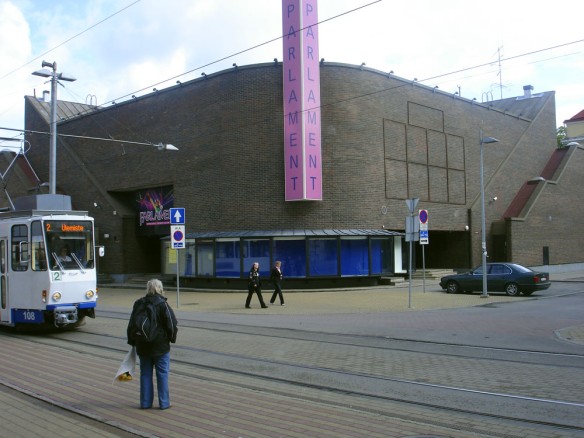The corner of Tartu maantee and Liivalaia (Approximately 1 km
east of the old town). A typical residential building of the Stalinist
period with spire and star at the top of the corner building.
EXAMPLES ON SOVIET ACHITECTURE. TALLINN
Residential building of the Stalinist period. The corner of Tartu maantee and Liivalaia.
Supermarket for the Communist nomenclature and foreigners. Tartu manntee 17.
A former club for Soviet Naval Officers, today a hotel. The corner of Vana-Posti and Suur-Karja.
The Soprus cinema, the former “Friendship Cinema”. The corner of Vana-Posti and Müürivahe.
The suburb of Lasnamäe. Built in the 1980s for 100,000 people resettled from other parts of the Soviet Union, mainly Russia.
Tallinn Technological College. The corner of Suur- Ameerika and Pärnu manatee.
Club for Soviet Naval Officers. Mere puistee 5.
The Olympic building complex, Linnahall, Mere puistee 20.
Building for the Union of Artists. Valli Street, Old Town.


Supermarket for the Communist nomenclature and foreigners,
Tartu manntee 17 (Approximately 1 km south-east of the old
town). The building is without windows because there was nothing
to see or buy for ordinary people.

A former club for Soviet Naval Officers, today a hotel. The corner
of Vana-Posti and Suur-Karja (Old town). The house was built in
1952 after the Second World War when the main part of the old
town lay in ruins.

The Soprus cinema, the former “Friendship Cinema”. The corner
of Vana-Posti and Müürivahe (Old town).

From the suburb of Lasnamäe. Built in the 1980s for 100,000
people resettled from other parts of the Soviet Union, mainly
Russians. (Heidi Tooming, Estonia).

Tallinn Technological College. The corner of Suur-
Ameerika and Pärnu manatee (1 km south-east of the old town).

Club for Soviet Naval Officers. Mere puistee 5 (south of the edge
of the old town). Today home to the Russian Cultural Centre.

Linnahall, Mere puistee 20 (just north-east of the old town at
the harbor). The building complex Linnahall, the former V.I. Lenin
Palace of Sports and Culture. Built in connection with the 1980
Olympic Games in Moscow. The sailing events took place in
Tallinn. Linnahall consists of concert halls and ice hockey rinks and
facilities for several other activities. It also has its own harbor and
helicopter landing pad.
The big and relatively flat complex of 27,215 square metres has no
windows. It looks like a military fortification and it is a very special
experience to stand on the top of this enormous complex and
look over to the sea and the old town of Tallinn. There is no other
building like it anywhere else in the world.



The building for the Union of Artists from the 1950ties. The building is decorated with Soviet symbols and contains studios and apartments for artists as well as art shops. These functions are still present today. Valli Street, Old Town.

The building for the Union of Artists from the 1950ties. The main entrance with Soviet symbols and still with art shops at the street level. Valli Street, Old Town.
EXAMPLES OF ARCHITECTURE FROM THE SOVIET PERIOD
After the collapse of the Soviet Union, nearly all Soviet symbols, adornments, statues, etc. were removed in the former Soviet countries. All street names referring to the Soviet Union or Communism were changed.
In Tallinn, however, a significant part of Soviet architecture was preserved, also with Soviet adornments.
There have been plans and wishes in all countries to remove large and conspicuous Soviet monuments but it is difficult and expensive to remove such buildings such as the cultural centres and palaces in Warsaw and Riga, as well as the Concert Hall complex at the port of Tallinn.
Many of the old town centres are also influenced by Soviet buildings, without taking account of the original architectural values, especially new buildings erected immediately after the Second World War, when many town centres were subject to considerable destruction.
The following describes some examples of Soviet architecture and adornments in Tallinn. Many of the buildings are dominated by classical elements such as pillars and adornments. This neoclassical architecture was very popular among the Soviet political elite because it was an expression of the power of the state.